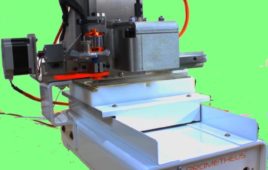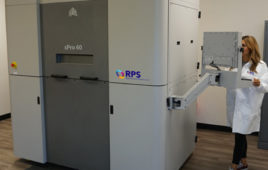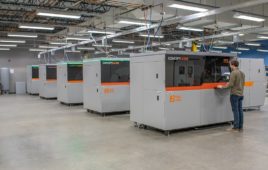Robots are becoming more powerful and useful by the minute. On a daily basis, design engineers struggle to make each new design more autonomous, fluid, independent, and lifelike. Some are designed for manufacturing purposes, others are designed to help the disabled (the applications are many). Still, others are simply designed for recreational purposes, such Project Hexapod’s six-legged, hydraulic robot, Stompy.
James Whong, Dan Cody, and Gui Cavalcanti have long dreamt of a giant, rideable robot. When the trio met at the Franklin W. Olin College of Engineering in Needham, MA, they decided to make their childhood dream a reality two years after graduation. Taking advantage of Cavalcanti’s connections with the Somerville, MA-based makerspace, Artisan’s Asylum, the three engineers decided to offer a class that would help with time, money, and commitment.
Makerspaces, such as the Artisan’s Asylum, are engineering collectives that are community-operated, and popping up around the nation. They are spaces for people with common interests to meet, socialize, and/or collaborate on major projects.
“The class was called ‘Robotics Intensive: Rideable Hexapod’,” explains Cody. “We offered a four-month class for $750, and it sold out within four hours of the announcement. We set it up through the infrastructure that the Artisan’s Asylum provided. They are the largest makerspace on the East coast, and they really help provide the ‘how’ and ‘why’ for our project.”
The class consisted of Whong, Cody, and Cavalcanti acting as instructors for fifteen students with the assistance of a teacher’s aide. “The original four-month period has already run out,” says Cody. “It ran from April until the end of July; and it culminated in the launch of our Kickstarter campaign. We will not be offering additional classes to work on it, but the same team that formed during the class has continued to work on it, with the motivation coming from the sense of ownership and involvement in the project.”
Cody describes how many of the students stayed with the project and continued to attend weekly meetings, and helped to solve the many challenges that popped up with the welding, coding, etc.
The initial motivation for Stompy was to build a rideable robot, so the team could ride off into the sunset with their significant others. “The robot is actually closer to art,” says Cody. “We don’t expect that this will have any practical applications, but you can imagine technology very similar to this being used for disaster recovery. Having six feet of ground clearance allows for impressive terrain navigation.”
The team hopes the project will bring hydraulics into the realm of hobbyist robotics. “We are not the first to use hydraulic tools in a hobbyist setting, but it’s not common,” explains Cody.
During the initial planning, the class spent several months trying to figure out how to avoid hydraulics, because their core skill sets dealt mostly with electromechanical actuators. “When we were figuring out the calculations, we discovered that we would need 1,600 Amps just to have the robot stand still,” says Cody. “We realized at that point that maybe we should stop fighting it and figure out the hydraulics route.”
According to Cody, a decent amount of hydraulics domain knowledge is available; from how to size the hoses; where to source the fittings and the actuators; to what kinds of valves are needed and how to work with all of the different components.
“All of our hardware and software designs will be released under an open source, MIT-style license at the conclusion of the project,” says Cody. “What we hope to give back to the community is an example of how to use hydraulics in a project like this; inspiring more interesting projects down the road.”
Because hydraulics is a very industrial field, trying to figure out where to get all the components was itself a challenge. To test the components, they created a one-half scale prototype, “Gimpy”. “We ran around to about nine different shops in the greater Boston area; some of which are just garages filled with bins of parts that we had to search through,” says Cody. “Another challenge we faced: getting the right components and putting them together in the right way that wouldn’t damage them. What is common knowledge in the hydraulics industry wasn’t common knowledge to us.”
To figure out the mechanics of the robot, the team used SolidWorks. On the software side of things, the team had their own simulation environment that they wrote in Python using PyOED and OpenGL.
“We split the project into three tracks: mechanical, electrical, and controls,” says Cody. “Gui is by far the most competent mechanical engineer, so he leads the mechanical side of things. James is the best electrical engineer, and the electronics for this project are not very complicated, so he has single-handedly taken care of that. James and I both have worked on the controls, and the students have sorted themselves into the tracts that they feel comfortable in.”
The team has weekly meetings to discuss the progression of the robot, and students come in to tackle certain tasks that need to be completed two to four days a week. “We have a pretty loose structure and flat hierarchy,” says Cody.
At the moment, the team is running a full-scale prototype leg. The data the team receives from this prototype will remain in their text platform throughout the duration of the project, and the team is hoping to complete the rest of the full-sized legs in early 2013. “The bottom of the robot will be six feet off the ground, which will allow someone to stand under the robot,” says Cody.
The robot will have six legs, and it will feature a 135 horsepower propane engine that was scavenged from an old forklift. “We chose that particular engine so we could run the robot indoors and outdoors,” says Cody. “There is also a lot of equipment and infrastructure around to maintain the engine if it fails.”
The hydraulic pistons are sourced from Dalton Hydraulic; HydraForce and HydroAIr donated the electroproportional hydraulic valves; and the rotary encoders for all of the joints are from ams (formally known as Austria Microsystems). “The electronics that drive the valves and talk to the encoders have been custom designed,” says Cody. “Our next revision will communicate over Ethernet, which will make it easy to interface with our control software, which is also written in Python and runs on a standard PC.”
The team is expecting an hour of run time on a single tank of liquid propane, with the tanks being easily swappable. The robot will be able to walk up to 5 miles per hour, and its chassis is designed with wheels so it can be hitched to a trailer for easy transportation when the body is lowered to the ground.
The team has already completed simulations to validate many of their design decisions. “In a lot of the cases, we are able to lean on the Asylum community. A lot of people involved in the community have relevant knowledge that helped us to find solutions for some of the challenges that we face,” says Cody.
One of the main challenges the team faces is weld quality. “The links closest to the hexapod’s body experience very high torques,” says Cody. “In this part of the robot, we use three-eighth-inch steel, which is tricky to weld correctly.” The process involves preheating the steel with a torch, and then completing a careful TIG-weld with a quarter-inch filler wire. “You don’t want to get it too hot, because when it cools down the weld might crack simply from thermal strain.”
The team is shooting to complete Stompy this spring. Some of the students who have helped with the project have even expressed interest in using Stompy as a platform for future projects that they have in mind. “I would like to live in a world where there are a lot more large-scale hobbyist robotic projects,” says Cody. “It is a very different way to look at robotics, and I am excited to see what follows.”
Filed Under: Encoders (rotary) + resolvers, Rapid prototyping




